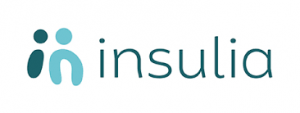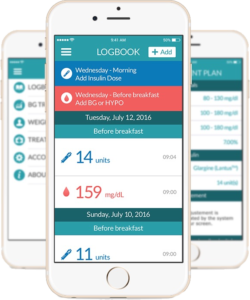Product Highlight
Condition targeted:
Type 2 diabetes


How it works:
Insulia® is a software medical device that supports insulin titration for people using any brand of basal insulin including Lantus®, Levemir®, Semglee®, Toujeo®, Tresiba® (U-100), and Basaglar®. It may be used on a compatible smartphone or computer.
Impact:
An aid in the management of diabetes. Insulia® is a prescription-only software medical device intended for use by healthcare professionals and their type 2 adult diabetes patients treated with long-acting insulin analogs as an aid in the management of diabetes.
Product Overview
Insulia’s legal manufacturer is Voluntis, an Aptar Pharma company
Medical condition:
Targets type 2 diabetes that is treated with long-acting insulin analogs.
Target patient population:
Adult patients with type 2 diabetes being treated with long-acting insulin analogs to manage their diabetes.
What to expect:
Recommends personalized insulin doses and coaches patients to better manage their diabetes.
Note: for more information, please visit https://insulia.com/
Clinical Overview
Indications for use:
Insulia® Diabetes Management Companion is indicated for use by healthcare professionals (HCPs) and their type 2 adult diabetes patients treated with long-acting insulin analog.
Insulia® Diabetes Management Companion is intended to provide secure capture, storage and transmission of diabetes related healthcare information, to enhance data management, to display reports and graphs, and to aid the HCP and the patient in the review, analysis, and evaluation of patient data in order to support effective diabetes management.
Insulia® Diabetes Management Companion includes a basal calculator intended to provide direction to the patient in response to blood glucose and health events, within the scope of a pre-planned treatment program from a healthcare professional for insulin adjustments, similar to the directions provided to patients as a part of routine clinical practice.
Insulia® Diabetes Management Companion includes software intended for use on commercially available mobile platforms, personal computers, in the home or in professional healthcare settings, and uses generally available networks and communication protocols.
Insulia® Diabetes Management Companion is not intended to replace the care provided by a licensed healthcare professional, including prescriptions, diagnosis, or treatment.
Outcomes:
See the Clinical Trials section for EU clinical outcome information. No clinical outcomes have been reviewed by the FDA, therefore the cited clinical study does not establish any efficacy claim for Insulia in the United States.
Directions:
Healthcare practitioners prescribe the app by creating a treatment plan tailored to the person’s needs, which generates an activation code. When the person downloads the app and enters their code, Insulia® is already set up to follow their personalized dosing plan. They just add their fasting blood glucose values and Insulia® will recommend basal insulin doses every day. Whether people take their insulin in the morning or evening, experience hypo symptoms, or switch insulins, Insulia® adapts to its users so that they have accurate and reliable dose recommendations at their fingertips.
Since Insulia® connects to a corresponding web portal, healthcare practitioners are able to follow their patients’ progress in real-time and help them when needed. Coaching messages and support ensure that people are never alone as they work to get to the right dose.
Risks & warnings:
Insulia® should not be used for basal dose recommendations with intermediate-acting insulin (NPH – Neutral Protamine Hagedorn) nor with premixed insulin. Insulia® is not intended for use by pregnant women, non-adult patients, or patients that are treated with a basal-plus or a basal-bolus regimen (i.e. including multiple mealtime insulin injections per day or insulin pump therapy).
Place in therapy:
Complementary to basal insulin therapy.
Product Access
Product description:
Insulia® is a software medical device that supports insulin titration for people using any brand of basal insulin including Lantus®, Levemir®, Semglee®, Toujeo®, Tresiba® (U-100), and Basaglar®. It may be used on a compatible smartphone or computer.
Prescription status:
A prescription is required from a qualified healthcare provider.
Patient access:
Patients download Insulia® through their smartphone on the Apple or Google App Store. An enrollment code is generated for patients after their healthcare provider completes a prescription.
Use of this product requires access to:
- Internet or wifi – only for initial download and periodic syncing
- A mobile phone, tablet, or computer
Please carefully read product instructions before use.
Provider access:
Healthcare providers may access the Insulia® dashboard to prescribe Insulia® to their patients, as well as monitor for real-time health trends, potential issues, and view patient-generated health data. Patients are automatically triaged so that those who need attention are seen first. These dashboards are accessible through the Insulia® clinician web portal and through tailored notifications.
Coverage options:
Insulia® is typically paid for by insurance plans. A Savings Program may be available.
Product availability:
Insulia® is available in:
- USA: FDA-cleared Class II Medical Device
- EU: CE mark credentialed by Gmed (class IIb)
- Canada: MDL delivered by Health Canada (class II)
A Day in Life with Insulia®
Insulia® was the first prescription-only digital therapeutic to receive FDA clearance for basal insulin titration.

Clinical Trials
The provided set of evidence represents a sample of conducted studies. For a comprehensive collection contact manufacturers directly.
Disclaimer: These clinical outcomes have not been reviewed by the FDA and therefore are not considered as claims on the efficacy of Insulia® in the United States. These outcomes are not indicative of what could happen with Insulia®.
Study Title: Efficacy of two telemonitoring systems to improve glycaemic control during basal insulin initiation in patients with type 2 diabetes: The TeleDiab-2 randomized controlled trial
Study Design: Randomized controlled study with two arms: – Control, naive to basal insulin, just given insulin – Treated with Diabeo (digital therapeutic) + basal insulin
Outcomes: In the Telediab 2 randomized trial in France using a predecessor device to Insulia called “Diabeo-Basal” with patients naïve to basal insulin (baseline A1C 8.9±1.1%) there was a statistically significant difference in A1C between the control group and Diabeo-Basal groups at 4 months (7.96±0.88% and 7.47±0.9% respectively, p=0.0017). Twice as many patients in the Diabeo-Basal group achieved A1C <7% vs. control (Diabeo-Basal 29.8% vs 12.5%). This study showed that interventions using automated insulin titration software improved glucose control as compared with standard care. Diabeo-Basal is not approved nor cleared for use in the US.